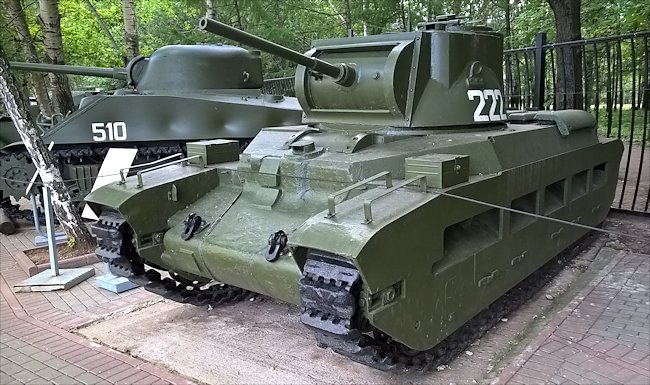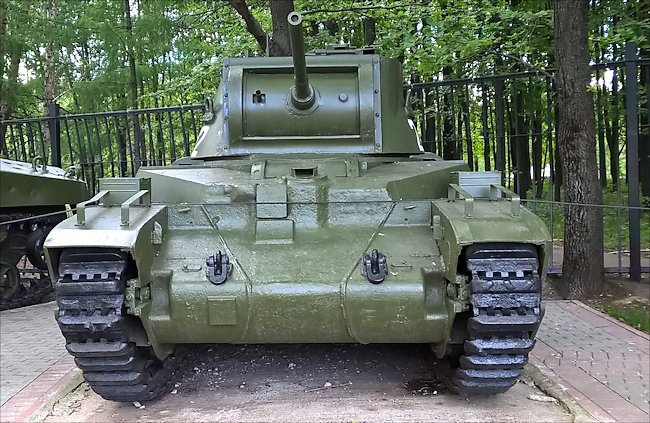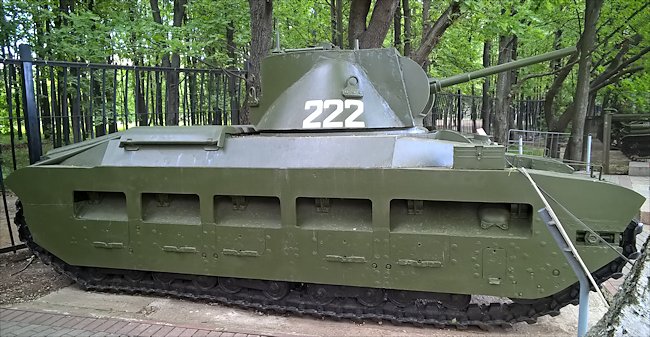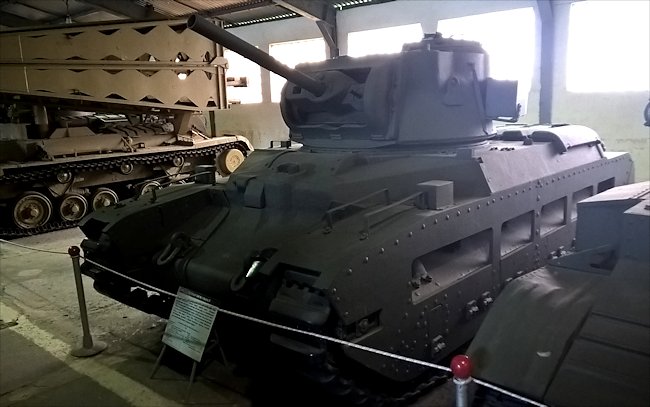Lend-Lease Matilda CS Close Support Tanks
Besides its own tanks, the Red Army used extensive quantities of Lend-Lease tanks like this British Matilda tank and other armoured vehicles from the USA, Great Britain and Canada. A total of 22,800 armoured vehicles were supplied to the Red Army during the war, of which 1,981 were lost at sea on the dangerous Arctic convoys.

Matilda II MkIII CS Close Support Tank in the Central Museum of the Great Patriotic War 1941 - 1945, Park Pobedy, Moscow. The turret is a reproduction, only the hull is original.
Location
To get to the Central Museum of the Great Patriotic War 1941 - 1945, Park Pobedy in Moscow you will find it in the road called Kutuzovsky Ave in the west of the city. The nearest metro station is Park Pobedy. The tanks are kept in an outdoor section to the left of the main museum building, as you look at the entrance. Follow the signs to the 'War Weaponary and Fortification' exhibit. There are no tanks in the main museum.
To get to the Russian Tank Museum in Kubinka Take the train from Moscow's Belorusskaya Railway Station, in the north west of the city, to Kubinka. It is about an hours train journey. It is a direct service, no need to change, and the tickets are cheap. Make sure you print off a list of station names so you can check off where you are and get ready to get off the train at Kubinka. The station names are not always easy to read or see.
Although this military town has been active for over 80 years it has a rundown look to it. You can walk to the museum but there is the equivalent to a motorway crossing your route. There are no pedestrian crossings over it. There are a number of taxi stands near the station. They are very cheap and honest. I tried to give the driver a big tip but he refused. Ask for his card so you can ask the Museum gate staff to call his company when you are finished at the Museum to get back to the railway station.

Matilda II MkIII CS Close Support Tank in the Central Museum of the Great Patriotic War 1941 - 1945, Park Pobedy, Moscow.
Specifications
The Matilda tank variant known as the CS Close Support tank was armed with a quick firing British Ordnance QF 3 inch (76mm) artillery howitzer gun that could fire high explosive HE shells. It could also fire smoke rounds. It had a range of 2,500 yards (2,300m). The Matilda II MkIII had a new twin Leyland diesel engine that produced 95 hp, in place of AEC engine of the previous versions. The Russians preferred diesel engines.
The Matilda II MkIV had an improved twin Leyland diesel engine, rigid turret mounting and no turret lamp. The tank was heavy for its small size. It weighed 25 tons. Its armour thickness ranged from 20mm to 78mm. It had a top road speed of only 16 mph (26 km/h) and an operational range of 160 miles (257 km). It had a four man crew: commander, driver, gunner and loader.

Matilda II MkIII CS Close Support Tank in the Central Museum of the Great Patriotic War 1941 - 1945, Park Pobedy, Moscow. The turret is a reproduction, only the hull is original.
Russian Matilda II Tanks
In total, Lend-Lease armoured vehicles amounted to about 20 per cent of the total number of armoured vehicles manufactured by the Soviet Union during the Great Patriotic War. These shipments were the equivalent of 16 per cent of Soviet tank production, 12 per cent of self-propelled gun production, and all of Soviet armoured troop transporter production, because the Soviet Union did not produce armoured troop carriers during the war.
The first shipments of tanks were dispatched in 1941, amounting to 487 Matildas, Valentines and Tetrarchs from the UK and 182 M3Al light tanks and M3 medium tanks from the USA. In 1942, Britain provided a further 2,487 tanks and the USA 3,023 tanks. The first units equipped with Valentines and Matildas went into service in the Staraya Russa and Valdai areas in December 1941 and January 1942.
It is interesting to note that these brigades were equipped with Lend-Lease and captured German tanks. Although the Soviets had hoped to form homogeneous Lend-Lease units, the Lend-Lease tanks were used in conjunction with Soviet tank types throughout the war.

Lend-Lease Soviet Matilda II MkIV CS Close Support Tank in the Kubinka Tank Museum Russia
Usually tank brigades or regiments were allotted a single type of Lend-Lease tank to simplify logistics. A typical example of Soviet units equipped with Lend-Lease tanks was the 38th Tank Brigade which in 1942 was equipped with thirty Matildas and sixteen T-60 light tanks. In 1943, the composition of Soviet tank brigades varied.
Brigades equipped solely with Russian tanks amounted to about 61—68 per cent of the force; mixed brigades (Russian and Lend-Lease), 19—22 per cent; solely Lend-Lease equipped, 10-17 per cent. At the beginning of 1943, there were 1,023 Lend-Lease tanks in Soviet units although 6,179 had been received since 1941. In 1944 and 1945, with a major influx of American M4A2 Sherman medium tanks, some tank corps and mechanized corps were equipped entirely with this tank type.
For example, in 1945, the 1st Guards Mechanized Corps was equipped entirely with M4A2 Shermans in its tank The role of Lend-Lease equipment in the Soviet war effort has been the source of bitter controversy, with some Western histories attributing to it a decisive impact on the war on the Eastern Front, and Soviet historians generally denigrating it as inconsequential.

Lend-Lease Soviet Army Matilda II MkIV CS Close Support Tank in Kubinka Tank Museum Russia
While the supply of Lend-Lease armoured vehicles was hardly decisive, it played a very useful role, particularly in 1941 and 1942 when the Soviet armoured force was recovering from the disastrous defeats of the summer of 1941, the evacuation of the tank factories and slump in Soviet tank production in the autumn and winter of 1941, and in the wake of the defeats in the Caucasus in the summer of 1942.
Lend-Lease tanks during this period played a vital role in preventing the tank strength of the Red Army from stagnating or actually decreasing. Neither should it be forgotten that Britain sent the Russians 14 per cent of her own tank production, even though the Soviet Union out-produced Britain three-fold in tanks, and this in 1941 and 1942 when the British Army was very short of tanks in the Western Desert.
Far more critical to the Soviet war effort was the supply of tactical vehicles, primarily from the United States. During the war, the Soviet Union produced only 343,624 cars and lorries due to the heavy commitment of major automobile factories like GAZ to armoured vehicle production. The USA alone provided the Soviets with 501,660 tactical wheeled and tracked vehicles, including 77,972 jeeps, 151,053 1—1/2-ton trucks, and 200,662 2-1/2-ton trucks.
This massive influx of vehicles provided the tank and mechanized corps with vital mobility in the 1944 and 1945 drives into Central Europe, and allowed the Soviet automobile industry to concentrate on armoured vehicle manufacture. The aid was vital, not only because of the sheer quantity, but because of the quality. While Soviet automotive production concentrated almost exclusively on antiquated copies of American 1930 lorry designs, the vehicles provided under Lend-Lease were modern military designs with multiple powered axles and useful cross-country capability.
The enormous influence of these designs on Soviet post-war vehicle design is very evident. Indeed, US trucks with their 'USA' serials still visible became so commonplace in Eastern Europe during the later years of the war that common folk-lore in the region interpreted these stencilled letters as meaning 'Ubiyat Sukinsyna Adolfa' (Kill that Son-of-a-Bitch Adolf).
Besides criticising the quantity of Lend-Lease armoured vehicles provided to the Red Army, Soviet historians have belittled the quality of the tanks provided. The Valentine and Matilda in particular have been singled out as being inferior to the T-34. This was evidently the case, but it should be remembered that the British Army did not have any better tanks at the time, and further- more, the Valentine and Matilda were far superior to the dreadful little T-60 and certainly comparable to the later T-70 which the Soviets were building in very large numbers.
One of the Matilda tank's major flaws was the abundance of snow and mud in Russia gradually clogged the drivetrain and suspension. Its narrow tracks was also an issue during the winter and the Russians devised a simple expedient, wielding sections of steel to each link for better grip in the snow. As the losses rose, and were not replaced, the Matildas practically disappeared by 1943 on the Eastern Front.
WW2 tank books

